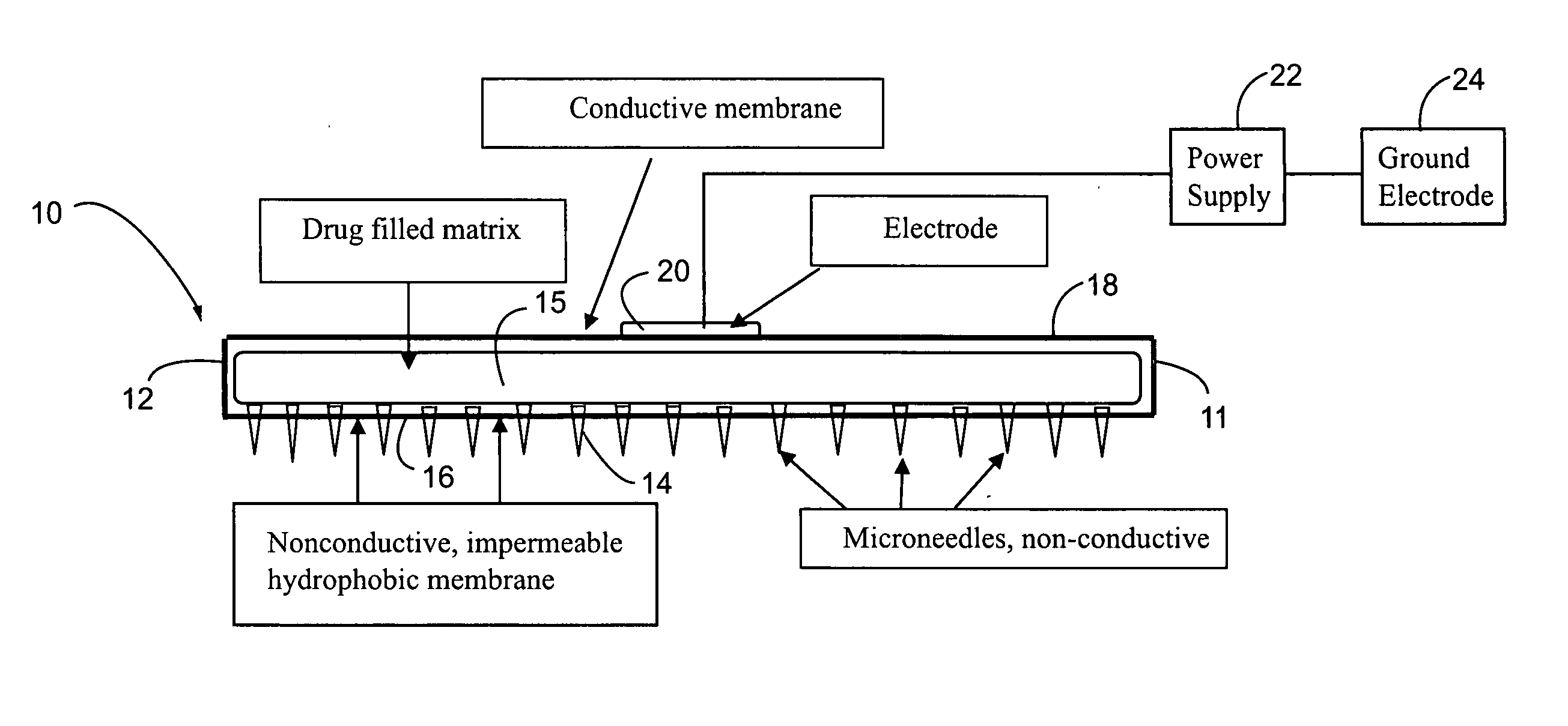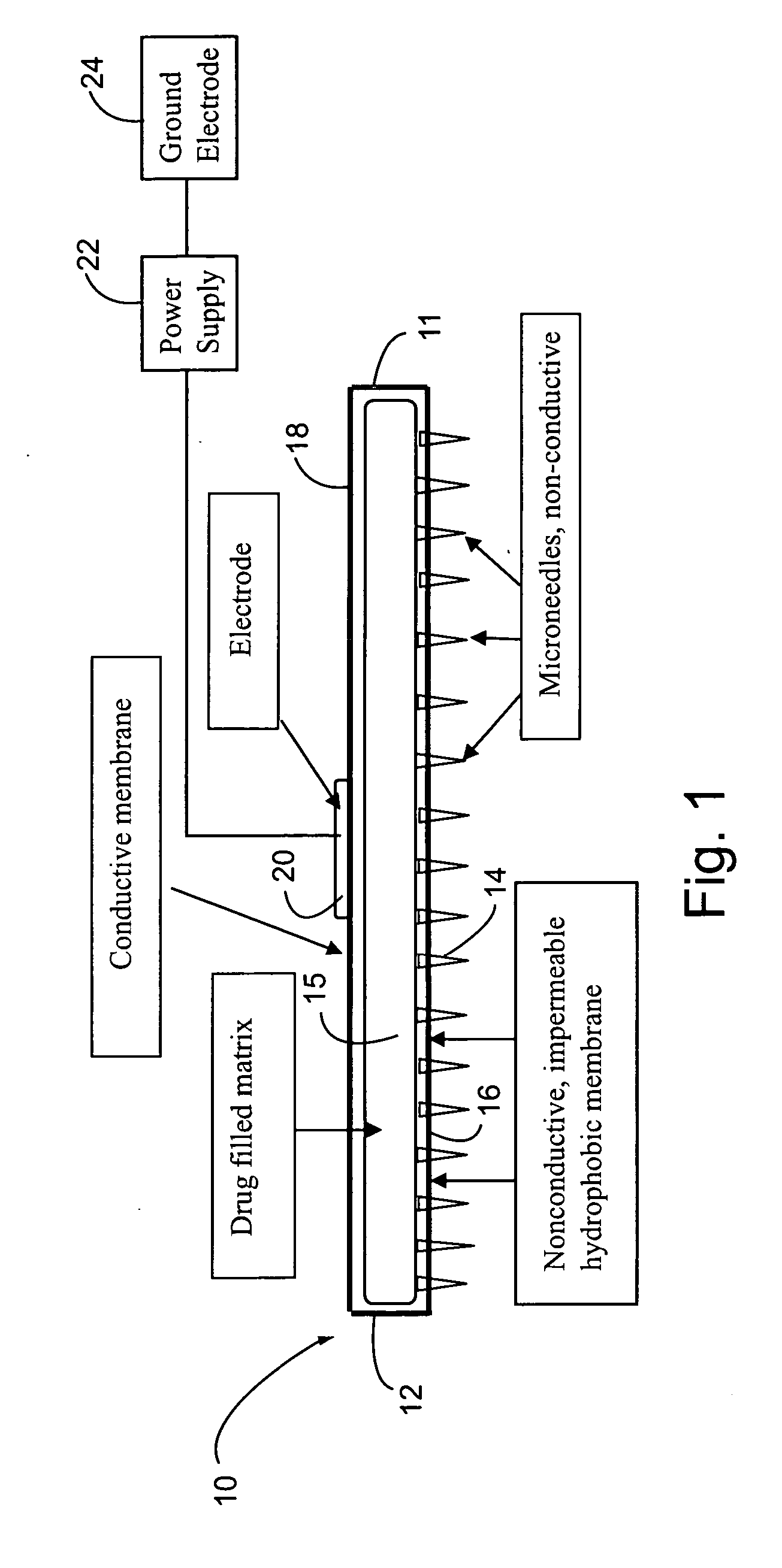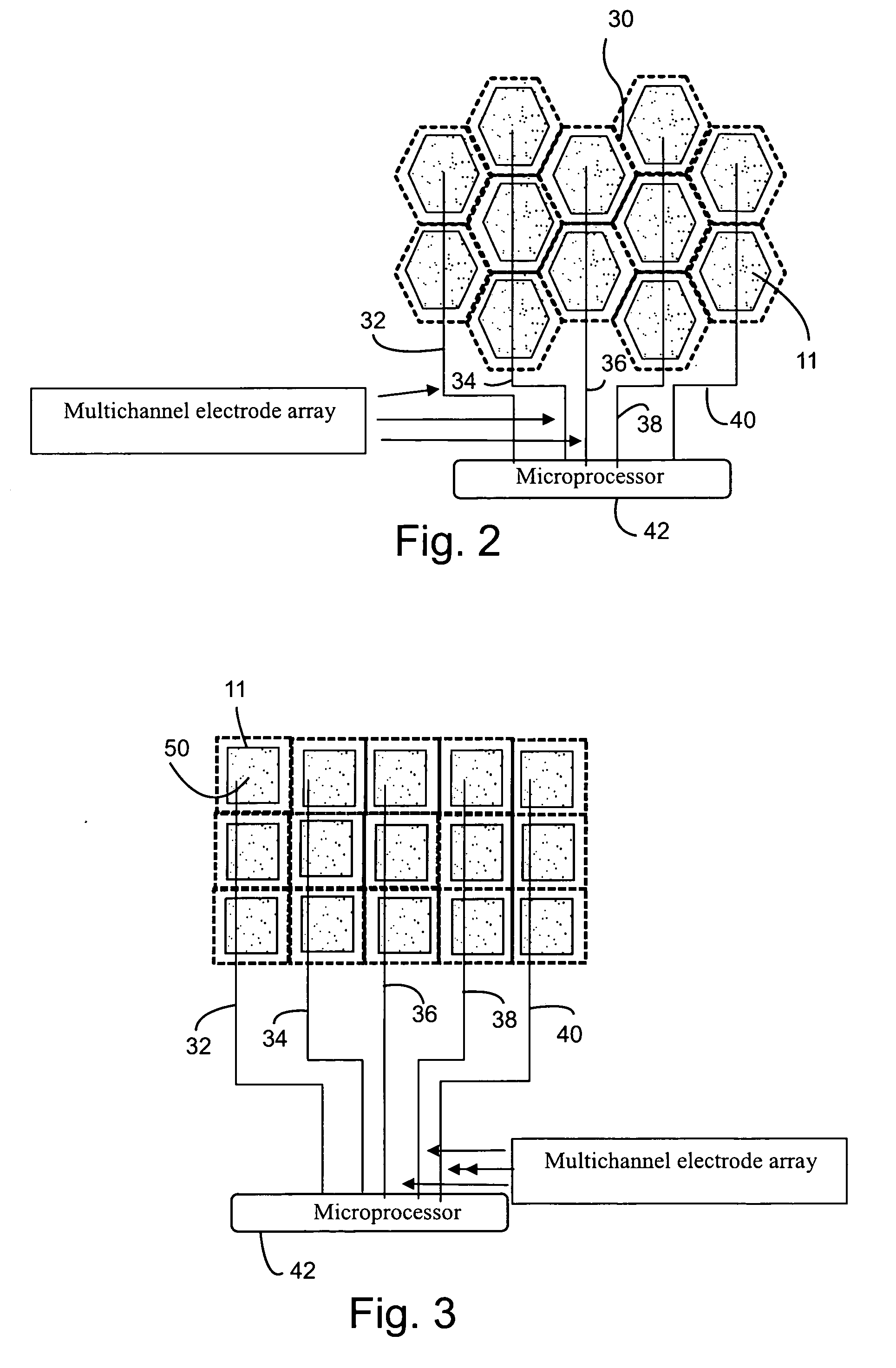[0007] The micro-needles may be attached to a flexible substrate to provide a compliant
system for skin interface. Micro-needles may not penetrate the epidermis to the full extent of needle height due to the compliant nature of the stratum-corneum and dermal underlayers. Additionally, skin is a viscoelastomer that relaxes mechanically under load. This causes the substrate to move away from the needle during puncture. One means for improving the consistency of puncture by needle arrays is to impose an upward movement of the skin using an iontophoretic patch. The patch may include a rigid boundary surrounding an array of micro-needles enabling, upon application, the skin surrounded by the boundary to present itself, i.e., become proud of skin adjacent the patch, to the micro-needle array. In another embodiment, to provide
skin penetration, the arrays of micro-needles are attached to a slightly concave-shaped elastomeric backing attached to the iontophoretic patch and acts as a suction cup. Upon actuation by the user, the target skin area is pilled into the concavity and against the micro-needles attached to the more rigid backing material. Micro-needles are thus allowed to penetrate the skin without interference from the more compliant dermal
layers below.
[0011] Advantages of using the present
delivery system include the capacity to increase the quantity of the substance delivered by reducing the resistance to penetration of the substance through the skin. The provision of multiple pathways, e.g., micropores enables delivery of an array of drugs, e.g., large molecules such as peptides, liposomes encapsulating hydrophobic drugs, or other encapsulated
drug formulations not currently
deliverable by electokinetic processes, particularly
iontophoresis. Further, by controlling the length of the needles, the substance may be delivered to selective targeted sites at different skin depths. For example, if just the
stratum corneum is penetrated, the underlying
layers of the epidermis are used as a substance reservoir with that area being loaded with the substance bypassing the
stratum corneum and enabling administration of the substance. Further penetration by the needles enables proximity to the
blood supply enabling
systemic administration of substances making the electrokinetic process appropriate for delivery of systemic drugs. Also, by locating the substance supply close to the
blood supply, the substance can clear its entry points quickly enabling substance delivery on a more continuous basis.
[0013] In a further preferred embodiment, there is provided a
system for delivering a medicament to a treatment site underlying an electrically resistant layer of an individual's skin, comprising an applicator for overlying the treatment site and the electrically resistant skin layer, the applicator having a plurality of needles projecting from one side thereof for penetrating the electrically resistant layer of the individual's skin; a matrix carried by the applicator for containing the medicament or the medicament and an electrical carrier therefor, the needles having one or more orifices in communication with the medicament or the medicament and the electrical carrier therefor contained in the matrix and opening at locations spaced from the matrix for delivering the medicament to the treatment site; a first
electrode for
electrical connection with a power source; whereby, upon application of the applicator to the individual's skin overlying the treatment site and connection to the power source and a second
electrode for
electrical connection with the power source enabling completion of an electrical circuit through the first electrode, the medicament or the electrical carrier therefor, a portion of the individual's body, the second electrode and the power source, the
system enables an
electrical current to flow for electrokinetically driving the medicament or the medicament and the electrical carrier therefor through the needle orifices into the treatment site bypassing the electrically resistant layer of the individual's skin.
[0014] In a still further preferred embodiment, there is provided a system for delivering a medicament to a treatment site underlying an electrically resistant layer of an individual's skin, comprising a power source; an applicator for overlying the treatment site and the electrically resistant skin layer, the applicator having a plurality of needles projecting from one side thereof for penetrating the electrically resistant layer of the individual's skin; a matrix carried by said applicator for containing the medicament or the medicament and an electrical carrier therefor, the needles having one or more orifices in communication with the medicament or the medicament and the electrical carrier therefor contained in the matrix and opening at locations spaced from the matrix for delivering the medicament to the treatment site; a first electrode carried by the applicator in
electrical connection with the power source; a second electrode in electrical connection with the power source; whereby, upon application of the applicator to the individual's skin overlying the treatment site and electrical connection to the power source and a second electrode for electrical connection with the power source enabling completion of an electrical circuit through the first electrode, the medicament or the electrical carrier therefor, a portion of the individual's body, the second electrode and the power source, the system enables an
electrical current to flow to electrokinetically drive the medicament or the medicament and the electrical carrier therefor through the needle orifices into the treatment site bypassing the electrically resistant layer of the individual's skin.
[0015] Another preferred embodiment of the present invention includes a system for delivering a medicament to a treatment site underlying an electrically resistant layer of an individual's skin, comprising a sheet of discrete applicators selectively separable from one another enabling one or more of the applicators to overlie the treatment site and the electrically resistant skin layer, each applicator having a plurality of needles projecting from one side thereof for penetrating the electrically resistant layer of the individual's skin; a matrix carried by each applicator for containing the medicament or the medicament and an electrical carrier therefor, the needles of each applicator having one or more orifices in communication with the medicament or the medicament and the electrical carrier therefor contained in the matrix and opening at locations spaced from the matrix for delivering the medicament to the treatment site; a first electrode carried by each applicator for electrical connection with a power source; whereby, upon application of one or more of the applicators to the individual's skin overlying the treatment site and connection to the power source and a second electrode in electrical connection with the power source enabling completion of an electrical circuit through the first one or more electrodes, the medicament or the electrical carrier therefor of the one or more applicators, a portion of the individual's body, the second electrode and the power source, the system enables an electrical current to flow for electrokinetically driving the medicament or the medicament and the electrical carrier therefor through the needle orifices of the one or more applicators into the treatment site bypassing the electrically resistant layer of the individual's skin.
 Login to View More
Login to View More  Login to View More
Login to View More 


